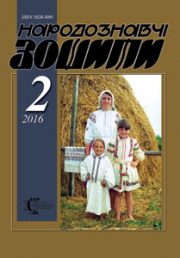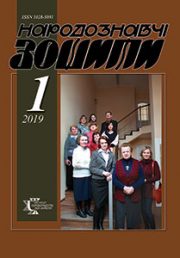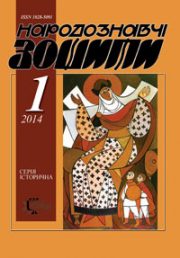The Ethnology Notebooks. 2018, 6 (144), 1528–1535
UDK 7.033.2:7.046:7.45
DOI https://doi.org/10.15407/nz2018.06.1528
Received 21.11.2018
CHURCH CURTAINS AND AERS DURING THE BAPTISING OF RUS: THE FORMATION OF THE RITE AND ICONOGRAPHY
ORCID ID: https://orcid.org/0000-0002-7411-0574
Matveeva Julia Genadiivna, a candidate of study of art,
associate professor
of department, is a design and fine art
at the Kharkiv national university of municipal economy
of the name of О.M. Beketova,
12 Kulykivs’kyi lowering, 61002, Kharkiv, Ukraine.
Contacts: e-mail: matveyevoy@gmail.com
Abstract, In the history of liturgical fabrics there is a period when very large pieces of fabric with embroidered subject images are called «aers». In modern practice, it is a small cloth (about 50 x 70 cm), which is carried along with the Holy Gifts at the Great Entrance, and then it covers the chalice and the discos, both set on the throne. In the period of 10—15 centuries these fabrics are very large (about 130 x 280 cm) and their use as modern aers was obviously impossible. The article discusses the reasons for the emergence of liturgical fabrics of such a large size and their use during the adoption of Byzantine liturgical tradition by Kievan Rus. It is revealed that at this time there is a gradual change in the liturgical practice associated with the fabrics. The altar curtains located on the ciborium above the Holy Table begin to be carried out during the Great Entrance, so the carrying out of the large air at the Grand Entrance, known until now, is gradually being formed. Gradually, large curtains are transformed into large aers. This is the most important period in the development of liturgical fabrics. Curtains have two branches of development: 1) they are transformed into large aers, from which the ceremony of carrying out the epitaphios would then appear and develop, and the aers themselves would decrease to the modern size; 2) the veils are transferred from the ciborium to the line of the altar barrier and the Royal Doors, from which the curtain of the Royal Doors or katapetasma emerge. Church fabrics had a long way of development and evolved during the church history. During the period of the baptising of Rus, one of the brightest stages of the functional transformation of fabrics occurs, namely, the curtains of the throne were transformed into the aers, carried out at the Great Entrance.
Keywords: baptising of Kievan Rus, curtain, veil, ciborium, iconostasis, the Great Entrance, liturgical veils, aer, iconography.
REFERENCES
German Konstantinopol’skiy, svt. Patriarh. (1995). Skazaniye o tserkvi i rassmoteniye tainstv. Moscow: Martis [in Russian].
Dvukratnij sobor. (21.11.2018). Retrieved from: https://ru.wikipedia.org/wiki/Двукратный собор [in Russian].
Dobronravov, G.S. (1912). Istorija katapetasmi. Moscow [in Russian].
Kanoni Pravoslavnoj Tzerkvi. Pravila Konstantinopolskogo Dvukratnogo Sobora. (21.11.2018). Retrieved from: https://azbyka.ru/otechnik/pravila/kanony-pravoslavnoj-tserkvi-grabbe/15 [in Russian].
Katasonova, E. (2006). Materiali k ikonografii pokrovtzov v litzevom shitije. Ubrus tzerkovnoje shitije. Istirija i sovremennost, 5, 4–38. Sankt-Petersburg, Izdanije zolotoshvejnoj masterskoj pri Uspenskom podvorije Optinoj pustini [in Russian].
Kiprian, (Kern) (2001). Eucharistia. Moscow: Hram Kosimi i Damiana na Marosejke [in Russian].
Kondakov, N.P. (1902). Pamyatniki khristianskogo iskusstva na Afone. Sankt-Petersburg: Izdanije Imperatorskoj akademii nauk [in Russian].
Lifshiz, L., & Smirnova, E.S. (Ed.). (2010). Pelena s «Paspatijem» i izobrazeniem Hrista, Bogomateri voplootysje i Apostolov na poliah. O vremenisozdanija i ikonograficheskom zamisle pamatnica. In Tzerkovnoje shitie Drevney Rusi. Sbornik statej. Posviashajetsja pamjati Ludmili Dmitrievni Lihachevoj (1937—2001) (pp. 39—47). Moscow: Galart [in Russian].
Matveyeva, J. (2018). Mova tkanin u vizantijskomu musteztvi. Kharkiv: HNUMG imeni O.M. Beketova [in Russian].
Matveyeva, J.G. (2015). Zavesa Nasivajemaja vozdukh: terminologia i realnij predmet. Drevnosti 2015. Kharkovskij istorico-arkeologicheskij yezhegodnik, 92—98 [in Russian].
Matveyeva, J., Sorochan, S., & Domanovskij, A. (2015). Izobrazitelnije liturgicheskije tkani IV—XVI vv.: evoluzija v obihode i iconografiji. «Vizantijskaja mozaika»: Sbornik publichnih lektzij Eleno-bizantijskogo lektorija pri Sviato-Panteleimonovskom khrame, 3, 112—162. Kharkov: Majdan [in Russian].
Pavsanij, Nikitijuk, E. (Ed.). (2005). Opisanije Elladi (Vol. 1, kn. I—VI). Translating from ancient Greek S.P. Kondratieva. Moscow: АСТ; Ladomir [in Russian].
Sizonenko, T. (2000). O vethozavetnoj simvolike tzarskich vrat. In Iconoctas: proisxozhdenie — razvitiye — simvolika (pp. 501—524). Moscow: Progress-Tradizija [in Russian].
Taft, R.F. (2010). Upadok prichasheniya v Bizantiji i otdaleniye miryan ot liturgicheskogo dejstva: prichina, sledstviye ili ni to ni drugoye? (D. Zanaveshennij altar). In Taft, R.F. Articles (Vol. 1, pp. 310— 365). Omsk [in Russian].
Troitzkij, V. (1912). Istorija plaschanitzi. In Bogoslovskij vestnik (pp. 505—530) Sergijev Posad: Tipografija Troitze-Sergijevoy Lavri [in Russian].
Brightman, F. (1965). Liturgy of the Presanctified. In C.E. Hammond, F.E. Brightman. Liturgies Eastern and Western; being the texts, original or translated, of the principal liturgies of the church. (pp. 345—352). Oxford: Clarendon Press.
Fleury, Ch. Rohault de. (1883). La Messe (Vol. 1). Paris: Vve A [in France].
Johnstone, P. (1967). The Byzantine Tradition in Church Embroidery. London: Alec Tiranti [in English].
Lampe, G. W. H. (1961). A Patristic Greek Lexicon. Oxford: Clarendon Press.
Migne, J.P. (Ed.). (1865). Patrologia curcus completes. Ser. Graeca (Vol. 86.2). Paris [in France].
Migne, J.P. (Ed.). (1860). Patrologia curcus completes. Ser. Graeca (Vol. 92). Paris [in France].
Migne, J.P. (Ed.). (1863). Patrologia curcus completes. Ser. Graeca (Vol. 108). Paris [in France].
Woodfin, W. (2004). Liturgical Textile. In W. Woodfin. Byzantium: Faith and Power 1261—1557. (pp. 295—323). New York: Metropolitan Museum of Art; New Haven: Yale University Press [in English].
Yarden, L. (1991). The Spoilts of Jerusalem on the Arch of Titus. A Re-Investigation. Stockholm: Astroms Fцrlag [in Sweden].






